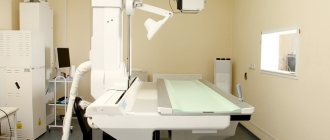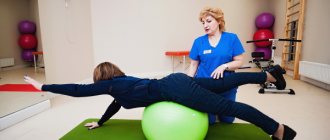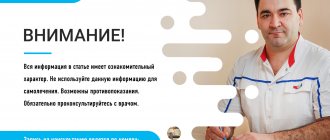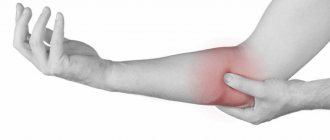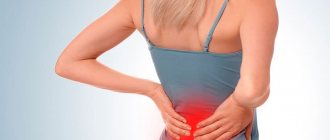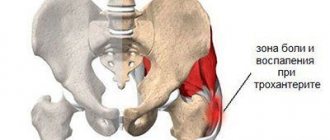Advantages of treatment in our clinic:
|
Possible causes of pain in the tailbone
Pain in the coccyx area can occur for a variety of reasons. There are many reasons and prerequisites for this pathological condition:
- Bruises and injuries. When riding a bicycle, skateboard, rollerblades or ice skates, falls are not uncommon. Unpleasant situations also happen during winter ice conditions. It is believed that landing on the “fifth point” is completely safe. However, in such a fall, the tailbone is the most vulnerable place. And pain after an injury manifests itself mainly immediately as a sharp, severe pain.
- Damage to the pelvic muscles, pinched nerves in the coccygeal region or in the perineum can also cause pain in the coccyx area.
- A prolonged sitting position leads to severe stress on the lower spine and threatens similar pathologies. There may even be curvature of the spinal ridge.
- All kinds of inflammatory processes in the pelvic organs (intestines, bladder, uterine pathologies in women, prostate problems in men, frequent constipation, hemorrhoids). All this can affect the tailbone.
- Skin diseases in the coccyx area (purulent fistulas and boils).
- Pain in the tailbone is possible during pregnancy, when the enlarged uterus, where the fetus grows and develops, puts pressure on the vertebrae. If the tailbone hurts after childbirth, it means the coccygeal region was injured or deviated back due to the large size of the child passing through the birth canal.
- Various infections, tumors (benign or malignant), bone spurs, cysts that arise in a certain coccygeal area can lead to unpleasant pathologies.
Prolonged sitting is a possible cause of tailbone pain.
In any case, so as not to cause pain in the tailbone, you should not endure it and wait for it to stop. If no changes for the better are observed within 2 weeks (maximum), you should visit a doctor.
Treatment of coccydynia
In order to properly treat patients with complaints of coccydynia, it is necessary to determine the true cause of this suffering, that is, to make the correct diagnosis.
Most often, these are functional and structural changes in the muscles and ligaments of the pelvic floor, which appeared as long-term consequences of injuries or osteochondrosis of the spine with hernias and protrusions of intervertebral discs. But pain in the coccyx can be caused by diseases of the rectum and organs of the genitourinary system, as well as injuries, tumors and infectious inflammatory processes in the coccyx or sacrum itself.
Sign up for a consultation by phone
Treatment
Treatment for pain in the tailbone is prescribed only by a doctor after determining the cause of the discomfort.
Medications
If the pain is aching in nature, then anesthetic and anti-inflammatory drugs used rectally will help relieve it. Ibuprofen or Nurofen are usually prescribed.
Ibuprofen Nurofen
For severe pain, anesthetic injections are used. With their help, pain is blocked. The procedure involves injecting anesthesia around the area of pain.
Manual therapy
Special techniques from a chiropractor improve blood circulation, relax muscles and relieve spasms. All this helps relieve the inflammatory process and reduce pain. The main problem is finding a highly qualified specialist. He must have extensive experience so as not to harm the patient. One wrong move by a chiropractor can cost the patient dearly.
Acupuncture
The procedure is based on inserting the tip of a needle into the point responsible for the pain syndrome that occurs in the tailbone. This type of treatment has no evidence of effectiveness, so doctors recommend using it only as a method of concomitant treatment. By choosing it as the main therapeutic method, the patient may experience worsening of the condition and the occurrence of complications.
Therapeutic massage allows muscles to relax. As a result of this, spasms disappear and pain goes away.
Physiotherapy
Physiotherapeutic treatment is usually prescribed for injuries and bruises. Such methods include the use of special devices that heat soft tissues, applications, and exposure to diadynamic currents.
Exercise therapy
Therapeutic gymnastics is indicated for pain in the tailbone, but you should not create an increased load or perform sudden movements. Jumping, running and other similar movements are not recommended. Exercise therapy is prescribed by a doctor. Only a specialist will determine which exercises are indicated in a given situation.
Unconventional methods of treatment
Treatment of the coccyx with folk remedies is performed only after consultation with a specialist, when the doctor diagnoses the absence of pathologies that caused the pain syndrome.
Using fir oil
A small amount of product is rubbed into the affected area in the morning, afternoon and evening. The product has anti-inflammatory, decongestant and analgesic properties.
Ointment prepared on the basis of mumiyo
This remedy has proven effective in treating coccyx injuries, even to the point of fracture. To prepare it, use mumiyo and butter, taken in equal quantities. The products are combined and mixed into a homogeneous mass. The product is used to treat the affected area in the morning and evening hours.
Radish juice
Radish juice in an amount of 300 ml is mixed with vodka (100 ml) and chalk (200 g). All products are mixed, and the finished product is placed in a glass container with a lid. The ointment is rubbed into the problem area in the morning and evening hours. The drug is kept in the refrigerator.
Valerian compress
Any natural fabric or gauze is soaked in valerian. The product is applied to the problem area. Cling film is placed on top, after which the compress is insulated and fixed. The bandage is applied in the evening and left until the morning.
The most radical treatment method is amputation of the coccyx. This operation is performed if serious injury to the organ has occurred, and other methods of therapy have proven ineffective.
Pain in the tailbone torments a person both at rest and during movement. A doctor will help you get rid of it after appropriate research.
Surgeon
If you have been referred to a surgeon, do not immediately fall into despair. It is quite possible that it will reveal a pinched nerve or dislocated cartilage. A specialist can cure all this without using a scalpel, but simply by sending it to a competent massage therapist.
In any case, based on the tests provided, he will accurately indicate the type, method and intensity of treatment. If it is a pinched nerve - exercise therapy, if it is a hernia - non-steroidal drugs, if there are serious complications - surgery. It is possible that coccyx disease is the result of osteo-disease, and the only treatment is regular calcium supplementation to prevent the development of the disease. In addition, the surgeon can refer you further to more specific doctors - be it an oncologist or other specialists.
When you first visit a hospital, always see your GP. Explain all your symptoms to him and you will most likely get a referral to the next doctor. Upon receiving a complete clinical picture, the surgeon and proctologist usually make a diagnosis within 5-10 minutes and prescribe the correct course of treatment.
We advise you to study - Blown back: how to treat the lower back, shoulder blades
Proctologist
As soon as the clinical picture becomes known and it becomes clear that the pain in the tailbone is not due to damage, you can be sent to see a proctologist. The proctologist will get acquainted with the results that were obtained after the examination, and therefore will express his opinion. This doctor may additionally conduct a palpating examination. In some cases, special tests may be needed.
Thus, a proctologist can detect various diseases that are in no way related to physical damage to the coccyx and prescribe truly correct treatment. For all those people for whom pain in the tailbone is only a symptom, an examination by a proctologist will be unpleasant. However, in most cases it finds the cause of the problem. If the proctologist cannot find the reason why the patient has pain in this area, he refers him to another specialist.
Pain can also be caused by pathologies of the prostate gland.
What research is needed?
If you are concerned about pain in the tailbone, then the following diagnostic measures are necessary:
- A thorough survey. Attention is drawn to previous injuries, operations, manipulations of the pelvic cavity and abdomen, and patterns of pain in the perineum.
- Neuroorthopedic examination of the condition of the pelvic joints, ligaments, muscles of the perineum, buttocks, and pelvic floor. Palpation of the pelvic floor muscles is carried out through the rectum.
- X-ray of the coccyx in two projections after preliminary bowel preparation (cleansing with an enema or laxative).
- Laboratory tests of blood and urine.
- According to indications - consultations with a proctologist, urologist, gynecologist.
Pain in the coccyx. Causes, symptoms, types, treatment and rehabilitation
The site provides reference information. Adequate diagnosis and treatment of the disease is possible under the supervision of a conscientious doctor.
In addition, poor blood supply in the coccyx area creates a favorable environment for the spread of infection. The duration of the infectious process leads to the formation of fistulas, which can connect to neighboring organs (for example, the scrotum, anterior abdominal wall, genitals and others) and the environment.
- In medical terminology, there is a syndrome called coccydynia, where “coccyx” is translated from Greek as tailbone, and the word “odyne” means pain. The main symptom of this syndrome is constant or cramping pain that occurs in the coccyx area.
- Most often, pain in the tailbone occurs in older people (55 - 75 years).
- Due to the anatomical structure of the pelvis, women experience pain in the coccyx several times more often than men.
Why does the tailbone hurt when sitting: causes and consequences
Seeing a doctor if your tailbone hurts when sitting is not uncommon among office workers. Usually these are young people who are busy with mental work and do not pay attention to their physical condition, do not engage in any sports or physical education. The second group of patients who often have tailbone pain when sitting are those who are actively involved in outdoor sports, ride a bicycle or train on an exercise bike, and are fond of extreme sports such as horse racing and alpine skiing. Most often, the reason why their tailbone hurts when sitting is the consequences of previous injuries.
One of the reasons why the tailbone hurts when sitting is the wrong chair or armchair. In the area of the coccyx there are important plexuses of nerve tissue. The muscle fibers that move the lower limbs are also attached here. Proper innervation and blood supply to this area of the body is of great importance. If the seat is not chosen correctly, soft tissues are compressed, vertebrae are displaced and cartilage tissue is deformed. Therefore, after prolonged sitting, many people experience a dull pain in the tailbone and a feeling of slight numbness in the lower extremities.
Somatic causes of tailbone pain when sitting include:
- rectal fistulas;
- proctitis and paraproctitis;
- hemorrhoids of the rectum and sphincter;
- gynecological diseases of the pelvic organs;
- anal fissures.
All these pathologies are accompanied by advanced clinical symptoms, which complement the pain in the coccyx. This may include discharge, palpable hemorrhoids, vaginal discharge, increased body temperature, and pain during bowel movements.
My tailbone hurts: which doctor should I turn to for help?
The coccyx is the name given to the lower part of the spine, which is a group of non-developing and fused vertebrae present in our body as a rudiment.
Although this part of our body has lost its importance in the process of evolution, its integrity is still very important for a comfortable life.
Unfortunately, it is not always possible to avoid damage and bruising of the coccyx, which is susceptible to diseases characteristic of the spine. For this reason, we will consider the question “which doctor should I see for pain in the tailbone?”
When the first symptoms appear...
The patient needs to be diagnosed to determine the level of injury to this organ. Therefore, if the tailbone hurts, the patient should contact a proctologist, who will send him to one of the following doctors:
- neurologist;
- surgeon;
- osteopath;
- gynecologist (the help of a gynecologist is prescribed only if this is a patient);
- psychotherapist (sometimes the problem may be related to a psychological disorder);
- chiropractor;
Start of treatment
Oddly enough, most of the methods for treating diseases associated with the spine are quite conservative and do not involve surgical intervention, and their full complex looks something like this:
- The patient is as at rest as possible;
- A massage therapist, exercise therapy, chiropractor and physiotherapy (separately or simultaneously) are prescribed to accelerate the restoration of blood circulation;
- Administration of painkillers to relieve associated symptoms.
If your tailbone hurts, other diseases that are somehow related to this problem will also be treated. The specialist observing you will tell you where to go next.
It is worth noting that the situation develops differently from the example we have given in pregnant women and young mothers, who often complain of severe pain in the tailbone after childbirth.
The therapist, to whom the patient approached with the question: “My tailbone hurts, which doctor should I go to?” – is in an awkward position: he cannot use either an anti-inflammatory or an analgesic drug due to contraindications, and an X-ray examination, for obvious reasons, cannot be carried out.
Let's look at what some treatment methods are for when your tailbone hurts:
- Manual therapy - carried out by an experienced specialist, will relieve symptoms by eliminating blood stagnation and excessive muscle tone, leading to spasm;
- Acupuncture – will reduce the intensity of the pain felt by influencing biologically active points (if the treatment is done by a professional, then complete healing of even severe pain is possible);
- Exercise therapy (therapeutic exercise) – development of muscles through gentle physical activity in order to avoid the occurrence of repeated spasms in the future.
- Physiotherapy is a whole range of measures, optionally prescribed by the attending doctor, aimed at alleviating and curing symptoms.
This list is not complete and can be supplemented depending on the individual case of each patient. My patients use a proven remedy that allows them to get rid of pain in 2 weeks without much effort.
Traditional methods of treatment
If your answer to the question is “Which doctor treats the tailbone?” – will be “Turn to nature”, then the following recipes and methods will be useful (do what is advised here only with the permission of a physician):
- Valerian compress (a cloth or cotton pad is soaked in valerian tincture, which can be bought at any pharmacy, and attached to the sore spot overnight);
- Rubbing in fir oil (up to 3 times a day);
- Iodine treatment (heat the treated area and apply iodine. Repeat 2-3 times a week for 1.2-2 months).
In conclusion, we note that as soon as you notice that your tailbone hurts, you need to think about which doctor to contact when the first symptoms appear (without wasting time) in order to prevent the disease from becoming “neglected”.
Who to contact?
Basic inspection
If pain in the tailbone occurs, you should consult a therapist, who will make a preliminary diagnosis based on a basic examination.
In order to understand exactly what to do, you just need to get tested
A standard examination includes the following diagnostic methods:
- X-ray of the pelvis to detect fractures and injuries;
- ultrasonography;
- computed or magnetic resonance imaging
- blood analysis;
- colonoscopy (in the absence of fractures and cracks in the coccyx).
After studying the results, the therapist will send the patient to a doctor with a more narrow specialization. The latter will make an accurate diagnosis and determine the path of treatment.
Traumatologist
The patient may have a spinal injury, severe bruises, or sprained ligaments. There is reasonable suspicion of a possible spinal fracture or joint subluxation. In such cases, he really needs the help of a traumatologist. This specialist will prescribe additional examinations, with the help of which he will determine the degree of damage to various components of the spinal region: muscles, blood vessels, bone tissue, nerves, as well as connecting elements and ligaments.
A traumatologist will help you cope with the pain.
If necessary, the traumatologist will apply a fixing bandage to the patient, and then may prescribe wearing an orthopedic or plaster corset to fix the correct position. In some cases, they may be prescribed spinal traction using a special device.
Prices for orthopedic corsets and posture correctors.
Proctologist
If the patient's tailbone is not injured, perhaps the cause of the pain will be discovered by a proctologist. After studying the diagnostic results, he will perform palpation and determine whether the pain is caused by problems with the rectum.
We advise you to study: Is it possible to cure osteochondrosis of the cervical spine?
Neurologist or vertebrologist
A neurologist can prescribe conservative therapy, during which the patient will take medications to relieve back and lower back pain. He will also check the patient for diseases of the spine, muscles, arteries, various tissues and the spinal cord. A vertebrologist will look for diseases of the joints and spine in the patient. This doctor will determine the treatment of neurological disorders in the patient and relieve him of pain in the tailbone.
Surgeon
The patient may also be referred to a surgeon. The doctor will determine the condition of the cartilage and bones. If it is possible to cope without surgery, then, if necessary, he will prescribe manual therapy or massage.
In more severe cases, when the cause of pain is cancer or a hernia, the surgeon will also initially prescribe conservative treatment methods. If they do not give positive results, the only option will be surgery.
The surgeon will help you get rid of pain in your tailbone without surgery.
Treatments that may be prescribed by your surgeon vary depending on the cause of the pain. If it occurs due to a pinched nerve, the doctor will prescribe physical therapy. In some cases, non-steroidal anti-inflammatory drugs may be prescribed.
Prices for traditional medicine for back pain.
Other doctors
Sometimes the doctors mentioned above cannot help with tailbone pain. In this case, it becomes clear that it was caused by another, more specific reason.
Gastroenterologist
A gastroenterologist is a specialist who can help resolve bowel problems. Having studied the problem and examined the clinical picture of the patient, he will prescribe the necessary medications.
Gynecologist
If the patient is a woman, then she should consult a gynecologist. It can solve the problem of pain in the tailbone if it is caused by a difficult pregnancy or difficult childbirth.
4.Diagnostics and treatment
Diagnosis of coccyx injury
The cause of the coccyx injury is largely determined based on the patient's complaints and physical examination. X-rays are used to determine whether a coccyx fracture or coccyx dislocation occurs. However, X-rays sometimes cannot detect these lesions. Some doctors recommend standing and sitting x-rays to accurately determine whether a fracture or dislocation is present.
A neurological examination may be required. To diagnose a tailbone injury, a rectal examination is also performed, if necessary. To do this, the doctor inserts a finger into the rectum up to the tailbone area to determine whether there is a dislocation or fracture. Rarely, if the cause of the discomfort is unknown, a local anesthetic is injected into the tailbone area to determine whether the tailbone is the source of the pain or if it is due to problems in other parts of the spine.
Treatment of coccyx fracture and other coccyx injuries
To treat a fractured tailbone, a special splint is applied, which is fixed in the area of the tailbone and back. The peculiarity of the treatment process for a coccyx fracture is that during the entire period of application of the splint you need to be at rest. This means strict bed rest for 2-5 weeks depending on the severity of the fracture. For the first few days after a tailbone fracture, you can only lie on your stomach. For particularly serious fractures of the coccyx, when the bones are severely crushed or do not heal on their own, surgery may be necessary. Surgeries on the coccyx are not considered complicated; they take place quickly and, in the vast majority of cases, without any complications.
In order to cope with the pain, the doctor will select suitable painkillers. After the plaster is removed, the patient is recommended to undergo a course of exercise therapy to make recovery faster and easier. Although a fractured tailbone usually heals within a month, many people experience tailbone pain for up to six months after treatment is completed.
If the patient is diagnosed not with a fracture of the coccyx, but with a dislocation or other injury to the coccyx, treatment may consist of only a few weeks of bed rest. If the coccyx is dislocated, the displaced vertebra is put in place, and then the doctor will also apply a fixation splint.
Causes
There are many causes of pain. For it to begin to manifest itself, only one reason from the list below is enough.
- Injury. Any injury to the tailbone, ranging from a simple bruise to a fracture or dislocation, causes acute pain, which can be either constant or intermittent.
- Spinal diseases (osteochondrosis, vertebral displacement, pinched nerves, etc.). Pain is felt in the tailbone and throughout the lower back. Similar symptoms occur with diseases of the rectum or sigmoid colon or exacerbation of hemorrhoids. It is also noticeable if the patient has pathology of the hip joints, bones and muscles.
- Prolapse of the perineum due to difficult childbirth.
- The presence of scars and adhesions, which are the consequences of a complex operation.
- Disorders of the gastrointestinal tract. This can cause constipation and diarrhea.
- Endometritis, cystitis, adnexitis, prostatitis.
- Coccyx cyst.
- Spending long periods of time in a sitting position. Because of this, salt deposits form.
- Emotional aspect. In this case, it is advisable to contact a psychosomatic therapist.
- Idiopathic pain that appears suddenly and disappears as well.
There are many reasons for pain in the tailbone.
It is important to determine what caused such feelings and work to eliminate it. It makes no sense to get rid of pain only: if the cause is not cured, then the pain will resume after a while
What happens to the tailbone when pain occurs in it
When the muscles of the lower pelvic floor contract on both sides, the tailbone bends forward; if the muscles contract on one side, the tailbone simultaneously bends and moves to the side.
Normally, movements in the sacrococcygeal segment in the anteroposterior direction are possible within 30 degrees, and lateral deviations are up to 1 cm. Such displacements of the coccyx on an x-ray should not be regarded as a fracture or dislocation. With spastic tension of the pelvic floor muscles, the tailbone in relation to the sacrum takes a position of excessive flexion, and pain most often appears.
Pain in the tailbone may intensify when getting up from a chair. This is explained by the tension of the gluteus maximus muscles, some of the bundles of which are attached to the lateral sections of the sacrum and coccyx.
Sign up for a consultation by phone
Which doctor should I contact for pain in the tailbone?
If pain in the lower back develops, you should consult a physician. The doctor will make a preliminary diagnosis and prescribe tests and studies to clarify the causes of discomfort:
- Ultrasound;
- X-ray of the pelvis to identify fractures and cracks;
- magnetic resonance or computed tomography;
- blood analysis;
- colonoscopy if there are no fractures or cracks.
The specialist examines the patient in a knee-elbow position and evaluates his sensations in the sacrococcygeal area, perineum and lumbar region.
Based on the examination results, the doctor may suspect a bruise, joint subluxation or spinal fracture. In these cases, the patient needs the help of a traumatologist, who will conduct additional examinations to determine how damaged the elements of the spinal region are - vessels, muscles, tissues.
In certain situations, the traumatologist applies a fixation bandage to the patient, and then prescribes wearing an orthopedic product or a plaster corset to fix the injured structures in the correct position. Sometimes the patient is prescribed spinal column traction.
If there are no injuries to the coccyx, a proctologist will help determine the cause of the pain. The doctor examines the results of diagnostic studies and palpates the anus. This method allows you to identify problems with the rectum.
A neurologist may prescribe conservative treatment, in which the patient needs to take medications to relieve severe pain in the lower back and lower back. The doctor checks the patient for diseases of the blood vessels, spinal cord, muscles and spine.
A vertebrologist looks for diseases of the joints and bones. It detects neurological disorders.
Often, after a therapist, a patient with pain in the tailbone is referred to a surgeon. A narrow specialist determines the condition of bones and cartilage. In some cases, the problem can be corrected without surgery - through massage or manual therapy. With the development of cancer and hernia, the surgeon prescribes surgery.
A gastroenterologist deals with problems with bowel movements. After studying the symptoms, he prescribes the necessary medications that can protect certain areas of the gastrointestinal tract. A gynecologist deals with problems related to women's health. Pain in the tailbone can be caused by difficult childbirth or a difficult pregnancy.
1.Tailbone injuries and their causes
A tailbone injury is a very unpleasant problem. As a result of the injury, the tailbone hurts and discomfort appears in this area (this condition is called coccydynia). The main types of coccyx injuries are bruise, displacement, dislocation or fracture of the coccyx. They heal slowly and require careful treatment. Most often, coccyx injuries occur in women, since their pelvic area is wider.
Coccyx
is a triangular-shaped bony structure located in the lower part of the spine. It consists of 3-5 bony segments held in place by joints and ligaments.
Causes of coccyx injuries
Most tailbone injuries are caused by trauma. A fall on the tailbone while sitting, usually on a hard surface, is the most common cause of a tailbone fracture or injury. Other causes of a tailbone fracture and other injuries may include:
- A direct blow to the tailbone, for example during contact sports.
- Injury or fracture of the coccyx during childbirth.
- Repetitive activities such as stretching or rubbing the tailbone (such as cycling or rowing).
- Less common causes of tailbone injuries include bony spurs, nerve root compression, injuries to other parts of the spine, local infections and tumors.
A must read! Help with treatment and hospitalization!
The structure of the coccyx
The coccyx is a vestigial bone in the human skeleton. It belongs to the lumbosacral spine. Anatomically it consists of 4 or 5 vertebrae connected together. But the coccyx, despite the fact that it is a rudiment, has significant significance.
The muscles interact with the coccyx ( or muscles (from the Latin musculus - muscle) - part of the musculoskeletal system in conjunction with the bones of the body, capable of contraction
) genitourinary system, muscles of the colon and buttocks. The coccyx can act as a support in distributing the load on the pelvis. But if a person sits down, then the tailbone ceases to be the main point of support, although he still takes part of the overload upon himself.
This is the anatomical structure of the rudimentary bone - the coccyx.
Pregnant women often talk about pain in the coccyx area, and this is understandable - extremely enormous pressure is placed on their lower back and coccygeal region, especially in the last trimester of pregnancy, when the weight of the fetus can reach 3-4 kg.
Each type of pain in the tailbone is personal, so you need to know clearly what causes the discomfort.
Surgeon
If you find yourself in the hands of a surgeon, this does not mean that everything is terribly bad. Don't run around in panic and don't fear for your life. Often, surgeons discover that the patient simply has a pinched nerve or has cartilage problems. In this case, the problem can be corrected non-surgically. You just need to use the services of an experienced massage therapist. If the surgeon discovers cancer or even a hernia, which results in pain, he will not immediately send you for surgery.
We advise you to study - Blockade for osteochondrosisFirst, the doctor will recommend an individual set of measures. If it does not help, then you will have to think about surgery.
Regardless of the disease, the surgeon will conduct an examination, study your tests, and then determine the method of treatment and its intensity. Pinched nerve - exercise therapy awaits you. If the whole problem is a hernia, then you will have to resort to non-steroidal drugs. But complications can only be dealt with through surgery.
Causes of pain
There are not so few of them. For example, injury to part of the bone skeleton. In this case, the pain caused by an injury to the coccyx is felt especially acutely. Some of these injuries include:
- bruise as a result of an unfortunate fall;
- fracture or crack in the bone;
- dislocation.
Diseases of the musculoskeletal system, in particular certain parts of the spine, can also cause pain in the tailbone area. These include:
- osteochondrosis;
- intervertebral hernia;
- pinched nerve.
Among the most likely causes of coccyx pain are the following:
- Pathological deviations in the structure of the hip joints.
- Diseases of the digestive system (for example, pain due to intestinal diseases or hemorrhoids). Often, diagnostics reveal problems associated with the digestive system when a lump appears on the tailbone.
- Perineal prolapse syndrome due to difficult childbirth or heavy physical exertion.
- The process of formation of adhesions and scars in the postoperative period.
- Deviations in the functioning of the gastrointestinal tract. Such conditions are often accompanied by constipation or diarrhea, which causes a characteristic pain syndrome in the coccyx area.
- Diseases of the urinary or reproductive system in patients of both sexes (for example, cystitis, endometritis, prostatitis or adnexitis).
- Cystic formation on the coccyx or malignant neoplasms.
- Prolonged stay in an uncomfortable sitting position.
- Disorders of the patient's mental state.
- Recurrent idiopathic pain. The appearance of such a syndrome is associated with disorders of neurological origin.
- Wrong choice of clothes. Often the cause of pain in the tailbone area is too tight and uncomfortable clothing.
- Muscle strain due to frequent and prolonged use of the toilet
- Carrying a child late in pregnancy. Such conditions are characterized by a significant increase in the load on the pelvic area due to the growth and development of the fetus.
My tailbone hurts - how to treat it? Correct diagnosis of the causes will allow us to establish effective methods.
What kind of pain occurs and what is it associated with?
Pain in the tailbone when sitting and standing is divided into 2 types:
| Name | Area of manifestation | Form of manifestation | Peculiarities |
| Coccydynia | The lower part of the spinal column, i.e. directly the coccyx. | Heaviness, sharp pain in the tailbone when standing up, redness and swelling are possible. | In each case, the pain is paroxysmal (less often, constant). Intensifies towards evening. |
| Anorectal | The anus area (affects the anus, inner thighs, and less often the reproductive organs). | Kinds: - stabbing, - aching, - stupid. |
When the tailbone hurts, the following is observed at the same time:
- increased sweating,
- activity restriction,
- gait distortion,
- pale skin.
Why does my tailbone hurt? Probable factors:
- getting injured,
- diseases (for example, osteochondrosis),
- excessive extension of fused vertebrae,
- prolapse of the perineum,
- pathology of the pelvic bones,
- cyst,
- diseases of the excretory and reproductive systems.
Less commonly, the causes of pain in the coccyx when sitting are considered idiopathic (“independent”, having an uncertain nature).
If your tailbone hurts when you sit for a long time, then the provoking factor is the habit of sitting on upholstered furniture and tight clothing that tightens the lumbar area.
Pain when standing up
If there is pain in the tailbone when sitting and standing up, then the likely cause is inflammation of scars that have not healed after surgery in the perineal area. Less commonly, discomfort is caused by adhesions in the pelvic area, which are also a consequence of surgical treatment.
Does your tailbone hurt when standing up? Make sure there are no signs of contusions (bruises, redness) on the lower back. If pain continues or gradually intensifies, seek medical help!
Pain in women in the tailbone when sitting can be caused by difficult childbirth. It manifests itself immediately after their completion or later (over 6 months).
Acute pain when standing up in the tailbone often “radiates” to the higher parts of the spine - the lower back and sacrum. Then patients report discomfort in the back, believing that the problem is related to pathologies of the spinal column (for example, its curvature).
Pain in the tailbone during menstruation
The causes of pain in the coccyx area in women during menstruation are gynecological or neuralgic diseases. Patients are recommended to begin treatment with a consultation with a gynecologist. If gynecological pathology is excluded, then you need to visit a neurologist.
Why does the tailbone hurt in women when sitting during the menstrual cycle? The high mobility of fused vertebrae in the female body, together with the changes that occur during menstruation, provokes increased discomfort in the “sitting” position.
When bending
Do you feel how much your tailbone hurts when you bend forward? In 85% of situations, the provoking factor is inflammation of the genitourinary system organs located near the lower back (bladder, uterine appendages, etc.).
Severe discomfort when bending occurs when:- cystitis,
- inflammation of the colon,
- intestinal dysbiosis,
- inflammation of the uterus, etc.
After injury
Acute pain in the coccyx area in men is usually a consequence of injury - a fracture, severe bruise, etc. It is provoked by a strong fall or blows to the buttocks and lower back.
Localization is different - the coccyx area or the area adjacent to it. Typically, pain appears immediately after injury and disappears when the factor that caused it is eliminated (for example, when a bruise heals).
During pregnancy
Pain in the coccyx area in women when sitting often occurs during pregnancy.
Why?
- lack of calcium,
- inflammation of the reproductive system,
- physiological characteristics.
Before childbirth, the structure of the pelvic region changes - growth of the fetus and enlargement of the uterus are observed, which leads to displacement of nearby organs. As a result, the fused vertebrae of the coccyx will deviate back, causing pain.
Postpartum discomfort indicates a birth injury (usually the result of a difficult birth) - an outpouring of blood into the soft tissues surrounding the vertebrae or their strong extension (observed if the newborn baby has a large head).
Above the tailbone
Pain above the lower spinal column indicates neuralgia (local pain along the nerve trunk). It is directly related to inflammation of the nerves coming from the lower back and sacrum.
Pain in the tailbone when running or walking
If your tailbone hurts when walking or running, then the cause is a heavy load on the body. Weakness of the muscle corset, incorrect position of the torso and damage to the spinal column in the past can provoke pain.
THEM. FATKHUTDINOV
Kazan State Medical University, 420012, Kazan, st. Butlerova, 49
Fatkhutdinov Ilsur Mansurovich - Candidate of Medical Sciences, Associate Professor of the Department of Surgical Diseases No. 1, tel. +7-987-225-11-35, e-mail: mail.ru
The article presents the results of examination and treatment of 22 patients (21 women and 1 man) suffering from pain in the coccyx. The causes and clinical manifestations of pain in the coccyx are described. The tactics for managing patients with this pathology are presented. Special attention is paid to the features of the examination of this group of patients and treatment regimens for patients with pain in the coccyx. Comprehensive examination and treatment can improve the quality of life of patients with this disease.
Key words: pain in the coccyx, diagnosis, treatment.
IM FATKHUTDINOV
Kazan State Medical University, 49 Butlerov St., Kazan, Russian Federation, 420012
Diagnosis and treatment of pain in the coccyx
Fatkhutdinov I.M. — Cand. Med. Sc., Associate Professor of the Department of Surgical Diseases No. 1, tel. +7-987-225-11-35, e-mail: ilsur1801 @ mail.ru
The article presents the results of examination and treatment of 22 patients (21 women and 1 man) suffering from pain in the coccyx. The causes and clinical manifestations of pain in the coccyx were described. The article presents the tactics of treating patients with this pathology. Special attention is paid to the peculiarities of observing and treating this group of patients. The complex examination and treatment can improve the quality of life of patients with this disease. Key words: pain in the coccyx, diagnosis, treatment.
There are no data on the frequency of patients with pain in the coccyx (coccydynia). It is known that coccydynia is more common in middle-aged females. The predominant prevalence of this pathology among women is explained by several factors: greater rotation of the pelvis and a wider pelvis, which increases the risk of injury to the coccyx [1]. Most often, coccydynia occurs when the nerves in the sacrum and coccyx are damaged. The disease can be caused by trauma (for example, falling on the tailbone or being hit by a hard object, trauma during childbirth) [1, 2]. Hemorrhage occurs in the tissue surrounding the coccyx, followed by the formation of scars and the development of myositis, which ultimately leads to a long-term, debilitating pain syndrome [2-4]. The pain is difficult to treat; these patients are “real sufferers”: clients of psychiatrists, hypnotherapists, psychics, healers [3].
Conservative methods of treatment that exist today using physiotherapeutic procedures (local darsonvalization, diathermy, electrophoresis with a 1% solution of novocaine, etc.), injection methods of treatment (periococcygeal alcohol-novocaine blockades, presacral blockades with hydrocortisone) do not always help patients [1, 2, 4]. Surgical treatment—removal of the coccyx—may not only not lead to success, but also aggravate the pain [3, 4].
The objectives of the study are to develop a diagnostic algorithm to identify the causes of pain in the coccyx and determine the optimal treatment regimen for pain in the coccyx.
Material and methods
During the period from 2007 to 2015, 22 patients with pain in the coccyx (21 women and 1 man aged from 25 to 64 years old). The duration of pain varied from 3 days to 6 months. A history of trauma in the coccyx area was noted in 16 cases, 1 case - there was no connection with the injury, 1 observation - the development of pain after surgical excision of the epithelial coccygeal ducts. Before contacting a coloproctologist, all patients were treated by a neurologist, surgeon, gynecologist, or independently (suppositories, ointments, painkillers), without effect.
All patients underwent a digital examination of the rectum with bimanual palpation of the coccyx, sigmoidoscopy, and radiography of the sacrococcygeal spine in two projections. Sigmoidoscopy excluded pathology of the rectum and sigmoid colon. X-rays revealed angular deformity of the coccyx in all patients (Fig. 1); deforming osteoarthritis of the sacrococcygeal joint was found in 95.4% of patients (Fig. 2). In 12 cases, osteodensitometry was performed, which revealed signs of osteoporosis in all cases.
Picture 1.
Angular deformity of the coccyx at the level of Co I- CoII vertebrae
Figure 2.
Deforming osteoarthritis of the sacrococcygeal joint
One patient was diagnosed with a dislocated coccyx three days ago, which was reduced under local anesthesia with a favorable result. In the remaining observations, taking into account the detected changes, complex treatment was carried out, which included paraarticular blockades, taking chondroprotectors, tranquilizers and calcium supplements with vitamin D3, and acupuncture. The first five blockades every other day were carried out with a solution of Lidocaine 2% -2.0 with the addition of Traumeel C 2.0 to relieve inflammatory processes in the muscles and ligaments around the sacrococcygeal joint. Then periarticular blockades were carried out with the addition of Alflutop 2.0 up to 10 times. In parallel, acupuncture was prescribed for 10 sessions. Therapy with chondroprotectors lasted for 2 months at a dose of 1000 mg per day. The drug “Adaptol” was used as a tranquilizer according to the standard scheme, which eliminated or weakened restlessness, anxiety, fear, internal emotional tension and irritability. The calming effect was not accompanied by muscle relaxation and loss of coordination of movements. Calcium preparations with vitamin D3 were prescribed at a dose of 500 mg per day for 2 months, with a repeat course after 1 month.
results
In two cases, no positive dynamics were observed against the background of complex therapy. Without waiting for the completion of the course of therapy, the patients were further examined: herniated intervertebral discs were found in the lumbosacral spine. After appropriate treatment by a neurologist, both observations noted an improvement.
The remaining patients noted positive dynamics after the first blockades and a course of complex therapy. In the long term (from 1 year to 5 years) there were no signs of the disease.
Discussion
Thus, complex therapy for pain in the coccyx, including para-articular blockades with the drugs “Traumel S” and “Alflutop”, acupuncture, taking chondroprotectors, tranquilizers and calcium supplements with vitamin D3, made it possible to relieve inflammatory processes and pain in the area of the sacrococcygeal joint, thereby improving quality of life of patients.
In turn, the lack of effect from the above therapy was a differential diagnostic criterion allowing one to suspect degenerative-dystrophic changes in the lumbosacral spine. It should be noted that when treating patients with coccydynia, in addition to examining the sacrococcygeal region, it is necessary to conduct an examination of the lumbosacral spine for a herniated disc, since pain in the coccyx area is secondary.
LITERATURE
- Maltsev V.N. Medical rehabilitation of patients with non-tumor diseases of the rectum, anal canal and soft tissues of the perineum. — Kharkov: Tornado. - 2004. - 202 p.
- Krasnov A.F., Arshin V.M., Tseytlin M.D. Handbook of traumatology. — M.: Medicine. - 1984. - 400 p.
- Rivkin V.L., Fain S.N., Bronstein A.S. Guide to coloproctology. - M.: Medpraktika-M, 2004. - 488 p.
- Fedorov V.D., Dultsev Yu.V. Proctology. - M.: Medicine, 1984. - 384 p.
REFERENCES
- Mal'tsev VN Meditsinskaya reabilitatsiya bol'nykh s neopukholevymi zabolevaniyami pryamoy kishki, anal'nogo kanala i myagkikh tkaney promezhnosti. Khar'kov: Tornado, 2004. 202 p.
- Krasnov AF, Arshin VM, Tseytlin MD Spravochnik po travmatologii. Moscow: Meditsina, 1984. 400 p.
- Rivkin VL, Fayn SN, Bronshteyn AS Rukovodstvo po koloproktologii . Moscow: Medpraktika-M, 2004. 488 p.
- Fedorov VD, Dul'tsev Yu.V. Proktologiya [Proctology]. Moscow: Meditsina, 1984. 384 p.
